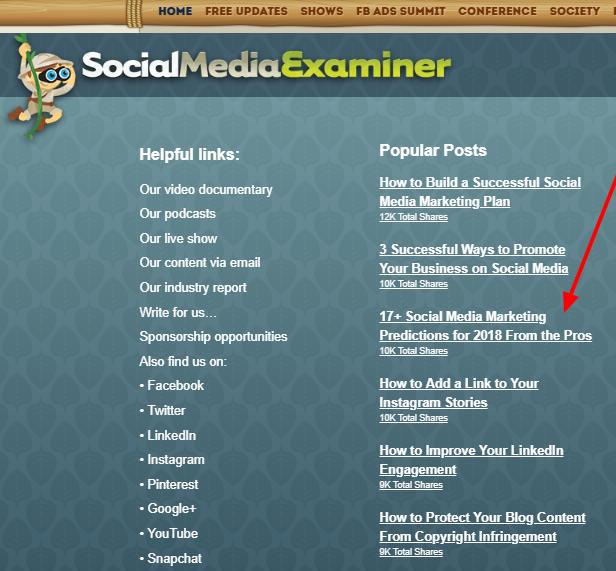Ever wonder why marketers still struggle with digital marketing despite all the instructional content out there?
Those who have succeeded with digital marketing have created detailed guides and case studies, sharing the steps that they took to achieve their results. Some people have been able to use those free resources to succeed, but many others still struggle and fail.
One of the problems with marketing tactics is that as they become more popular and everyone starts using them, they tend to lose some effectiveness. The competition becomes tougher, and you really have to stand out to be seen.
Sometimes, it's easier to find success by pursuing unpopular tactics that people haven't caught on to yet—or tactics that have fallen out of favor but still work.
In this article, I'll share three less-popular content marketing tactics that still work really well to generate traffic, links, and social shares.
1. List Posts
In the age of "10x content," list posts have become unpopular. Influencers are constantly promoting the idea that content has to be top quality to stand out since everyone is getting into content marketing.
As a result, bloggers are more focused on data-driven content, case studies with real-life examples, ultimate guides, and other types of content that promote thought leadership.
List posts and listicles, on the other hand, often seem too easy to create and lacking in authority. Just about anyone that can write can create a list post.
But list posts still work really well: They can drive traffic and links to your site. Neil Patel writes that Leo Widrich used list posts to promote Buffer and that lists posts drove over 100 signups per day for Buffer (check out lesson No. 3).
List posts alone might not make you an ultimate authority or thought leader in your niche. But they do drive traffic; they also get shared, and they attract links.
List posts are a content format you should consider adding to your content mix.
2. Expert Roundups
Another tactic that has fallen out of favor is expert roundups, which were popular in 2014. My very first roundup got over 5,000 social shares.
However, a lot of other inexperienced bloggers started doing roundups, and the tactic quickly fell from popularity, for several reasons:
- A lot of bloggers were asking uninteresting questions that weren't helpful to their target audience, or they were asking questions that had already been asked by others. Asking boring questions led to uninteresting answers and low-quality content that people weren't willing to share.
- People were asking the same influencers to participate in their roundups, and also creating bigger and bigger roundups with 50+ or more experts. Having too many people featured resulted in less exposure for each expert, and many influencers stopped participating because of low exposure along with the low-quality-content issue.
- What made matters worse was that bloggers started inviting nonexperts (who gave low-quality answers) just to have more people participating in their roundups.
- Finally, bloggers did a poor job of promoting their roundups, expecting them to just go viral on their own.
Despite negative perceptions about expert roundups, a well-executed roundup can still do well and get lots of backlinks, social shares, and exposure in general.
Social Media Examiner still does them, and its 2018 social media predictions roundup, "17+ Social Media Marketing Predictions for 2018 From the Pros," was still showing up as one of its most popular posts (10K social shares) in June, five months after publication:

So how do you do a great expert roundup? Here are three tips:
- Ask a question that will generate great responses. Spend time on thinking of a compelling question to ask experts. Visit forums and communities regularly or look at blog comments on popular blogs to see what questions people are asking or what issues they are struggling with.
- Have a strong promotion strategy or build an audience first. Influencers have limited time and they need to be selective about where they get featured. Having a built-in audience definitely helps to show that you've been effective at promoting your own content. Influencers want to know that you can promote and aren't just riding their coattails for more traffic.
- Use the "expert-infused" roundup format. Instead of just asking a question and having the article consist of experts' responses, write your own article like a journalist and quote extensively from experts. With this format, you pretty much guarantee that the content is shareworthy. The experts will be more likely to share it because the article is good and also because they might actually get some exposure from the article.
Andy Crestodina's annual blogger survey is a good example of that last format. In his article, he writes most of the content, thus ensuring the content is top quality, and he includes 10 influencer quotes: "Blogging Statistics and Trends: The 2017 Survey of 1000+ Bloggers" (1,000+ social shares).
3. Focusing on Building Relationships Along With the Backlinks
Building relationships isn't something that most marketers focus on, and you don't see a lot of case studies or data-driven content showing how effective it is. And because there isn't much data or research linking relationship-building to marketing success, you don't see influencers blogging about it much.
But building relationships is one of the most powerful tactics that influencers use to crush their competitors in marketing.
Leo Widrich had great success using guest-blogging to grow brand awareness for Buffer, a social media marketing tool he co-founded with Joel Gascoigne. In an interview with Eric Sui, Leo reveals that he wrote 150 guest posts in 9 months to get the tool's first 100,000 users.
But Leo mentions in another interview that the most valuable thing he gained from guest-blogging was not the backlinks but the relationships he formed as a result of the exposure.
Other marketers have used relationship focused approaches to grow even faster. One great example is how Alex Turnbull kick-started GrooveHQ's content marketing. Alex created an engagement schedule that allowed him to systematically reach out to influencers and build real relationships with them.
That strategy allowed the company to get over 5,000 subscribers within the first five weeks of publishing. Groove quickly grew into a seven-figure business and is now generating over $10 million in annual revenue, thanks to the success of their content marketing.
Summing It Up
List posts, expert roundups, and relationship-building are just a few marketing tactics that you may want to explore if you aren't already using them.
If you are struggling with marketing, consider taking a closer look at tactics that are no longer popular or are otherwise being overlooked by your competition.




